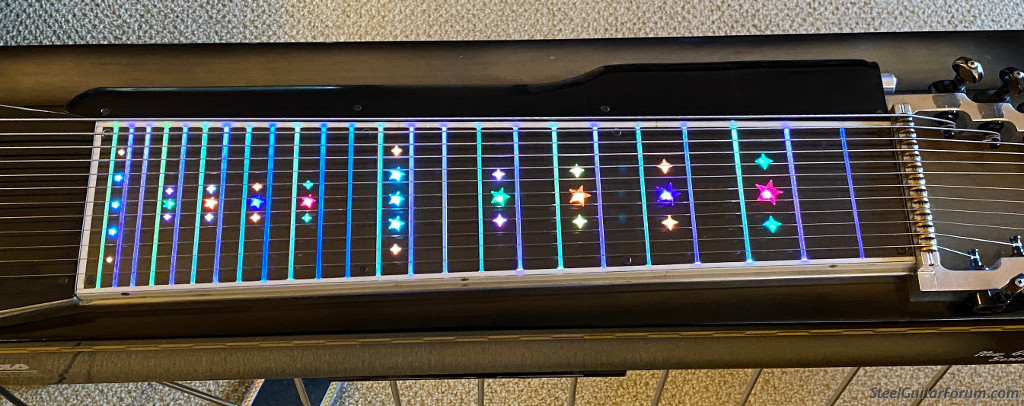A fretboard lit up by multicolor LEDs
Posted: 1 Jun 2021 10:20 am

I made a fretboard, with stars and frets lit by multicolor red-green-blue LEDs. There are LEDs under the stars that mark the frets, and another for each fret going into side-emitting fiber optics. I have no problems seeing the neck in a darkened nightclub! I was inspired by Jim Palenscar’s steel with very tasteful LED roses on his fretboard. The photograph does not do justice to the rich colors of the lights in the stars or in the frets.
It is printed with a 3D printer. The body of the fretboard is black ABS plastic, there are bindings on the edges that are white, and a black cover is over the electronics. The stars are printed in clear CPE, which are glued into star-shaped holes in the fretboard. The whole thing is covered by a thin clear polycarbonate covering to protect it. The colors are controlled by a PIC microcontroller. It has 3 levels of brightness, and a fourth mode with colors constantly changing (nice to look at for the novelty, but not changing the colors is better for playing). I put it on my U12 Thomas pedal steel.
I did not make this with the intent to sell it, however I am willing to share my ideas and designs if anyone is interested. I made it a few years ago, and if I had to do it again, I would use a Teensy 3.2 microcontroller and Dot-Star LEDs, which would simplify the wiring and make the electronics more compact. I retrofitted my steel to all of this, but it would work well to have this incorporated into the design of a new steel, to better accommodate placement of the electronics and the thickness of the fretboard.
It is not a small project, although from the comments I get about it when I am out playing, it was worth the trouble. Making it involved 3D CAD design, aluminum welding, printed circuit board (PCB) design, soldering static-sensitive CMOS surface-mount chips, and microcontroller programming. I had to make a new neck, which involved cutting and welding aluminum. My old neck was 3/4-inch-thick aluminum, so I needed one that was 3/4†thick at the pickups and changer end, dropping down to ½†thick under the fretboard to give enough room for the new board under the strings. There is a cutout underneath the first few frets to put some of the electronic components under the fretboard. The design change mentioned above would eliminate the need for this cutout. Printed-circuit boards hold the electronics, using surface-mount components. Each little strip of LEDs under the stars has a skinny PCB holding the LEDs in the correct places under the fret. Each side-emitting fiber optic fret has a skinny strip of shiny aluminum tape under it to increase the brightness of the fret, and a 3D printed housing connecting each LED to the end of each fret’s fiber optic.
The whole thing was 3D printed in pieces, so that they would fit into my 3D printer. The pieces interlock with each other and are glued together. These pieces could also be printed through a 3D printing service.
Vic Chaney
www.chaneyproductions.com/vics-creations